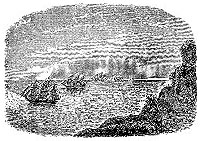

Since ancient times, mankind has pondered about the geometrical shape of our planet Earth.

Aristotle (384-322 BC) was among the first to recognize the fact of our planet being a round sphere. He observed lunar eclipses and noticed that only a round sphere could imply a circular shadow.
This astronomical observation was confirmed by general observations made at sea. When a ship sails away from the coast, it seems to disappear gradually behind the horizon.
The next scientific step, directly measuring the size of our planet, was performed by Erathostenes (276-194 B.C.).
In 1996 - 97, several EAAE - Astronomy On-Line students have repeated these measurements: click to see a general description. Their results did fit within 10 percent of the true values.
Based on reports by sailors, Erathostenes actually prepared reasonably accurate maps of the lands and seas known to him.
![[Image - ancient world map]](images/nava02b.gif) [JPG, 47k]
[JPG, 47k]
The World Map by Erathostenes, approx. 250 BC
Later, efforts were made by Ptolemeus to improve the maps by Erathostenes - unfortunately, Ptolemeus applied a size of the globe that was far too small.
![[Image - Sailing Ship]](images/nava03a.gif)
As described in the EAAE Astronomy On-Line Lunar Eclipse Projects 1997, this error gave roblems to Christopher Columbus more than 1000 years later.
The maps known at that time - in the late 15th century - simply did not leave any space for additional continents.
So, when Columbus was looking for a new sailing route to India, he expected that by sailing in the opposite direction to all others - westwards instead of eastwards - he would find a shortcut.
As a result of this, Columbus never realized that he actually did discover a new continent, now known as "America". And even today, the Caribbean region of the World is referred to as the "West-Indies"...
1. Discuss Erathostenes' world map. Compare it to a modern map. What is missing?
2. If you live near the sea, try to watch a ship as it moves away from the coast and slowly "sinks" below the horizon.
3. Take a globe and discuss Columbus' idea.
First Page |